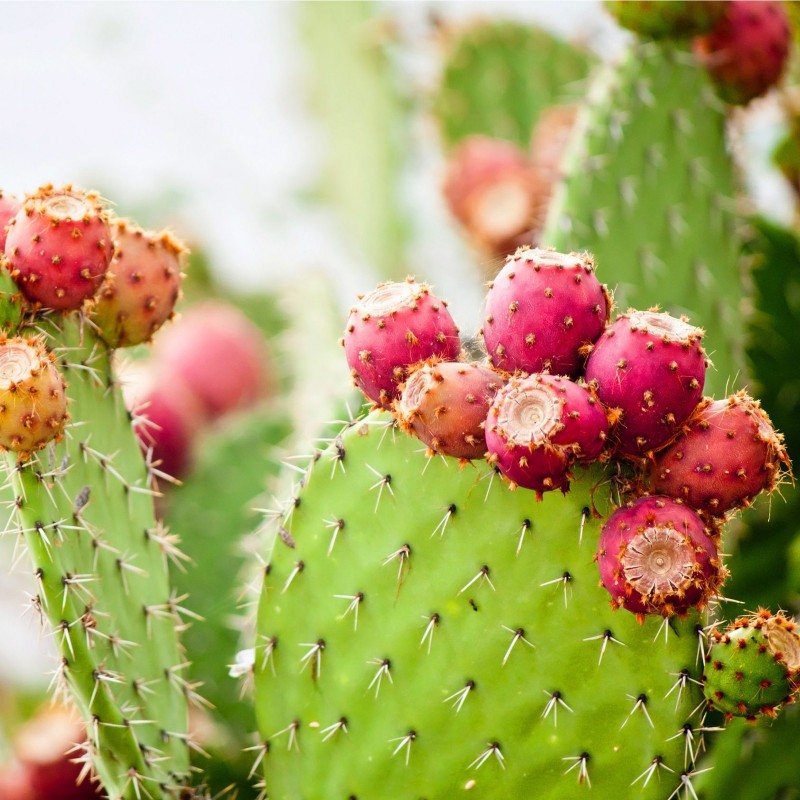
Wheel Cactus or Camuesa Seeds (Opuntia robusta)
Wheel Cactus or Camuesa Seeds (Opuntia robusta)
Price for Package of 10, 20, 40 seeds.
Opuntia robusta, the wheel cactus, nopal tapon, or camuesa, is a species of cactus in the family Cactaceae.[1] It is native and endemic to central and northern Mexico to within 100 miles (160 km) of the Arizona and New Mexico borders where it grows from 5,000 to 10,000 feet (1,500 to 3,000 m) on rocky slopes, open shrublands, woodlands, and mixed with other cactus and succulents.
Fruit; The fruit of Opuntia robusta is delicious, very juicy too! Fruit ripens around July for the first flush, then you can have a second flush around August/Sept. The fruit is very sweet and is excellent in fruit smoothies or for margaritas. The fruit is sweet/juicy and has a grape-like taste. Fruits or cactus apples are oval in shape and average 1-1/4" to 1-1/2" in diameter by 3-1/2" to 4" long.
Edible stems; Not only is the fruit edible but the stems or nopale pads are also edible in nopales salad. You skin the exterior and boil the stem flesh which is cut into narrow strips. The strips are then added to a fresh salad. High in nutrients and low in calories too, so very healthy!
Plants are commonly around 1 m (40 in) high, though they may grow to over 3 m (10 ft) high when supported.
The flattened stem segments are fleshy, round, and blue-grey in color. These are up to 30 cm (1 ft) in diameter and have the length of sharp spines up to 5 cm (2 in).[2] Yellow, sessile flowers with a fleshy base are produced on the edges of the upper stem segments. These are followed by barrel-shaped fleshy fruits which are pink or purple and up to 8 cm (3 in) long.
Taxonomy
The species was first formally described in 1837 in Enumeratio Diagnostica Cactearum hucusque Cognitarum. It has naturalized in the states of South Australia, New South Wales, Queensland, and Victoria in Australia.
We personally collected this seed, and we guarantee that the mother plant withstood temperatures of -15 degrees Celsius.
| Organic Seeds ? | Organic Seeds |
|---|---|
| Organic/natural ? | Organic/Natural: Yes |
| Edible ? | Edible |
| Pretreatment of sowing ? | Soak in water before sowing: 24-48 h |
| Sowing depth ? | Do not cover the seed just press into the soil |
| Life Cycle: | Perennial plant : Yes |
| Handpicked seeds ? | Handpicked seeds |
| Resistant to cold and frost ? | Cold resistant: to −15 °C |
| Seeds Gallery recommend this plant ? | Seeds Gallery recommend this plant! |


Your review appreciation cannot be sent
Report comment
Report sent
Your report cannot be sent
Write your review
Review sent
Your review cannot be sent
🌍 Worldwide Shipping from the EU
We ship worldwide from the European Union using registered air post with signature confirmation on delivery.
📦 Tracking Your Order
Log in to your account and go to Order History > Details to find your tracking number.
You will receive email notifications at every step — please check your spam/junk folder if you don’t see them.
Track your package via:
⚠️ Important Notices
Cash on delivery is not available.
Always provide a valid mobile number with country code when ordering (e.g., +365 456 7686 576).
Do not order to P.O. Boxes or if you cannot be home to sign for the package. We cannot leave parcels with neighbors.
If a package sent to a P.O. Box is lost or undelivered, you lose the right to a refund.
📦 Lost, Returned & Reshipping Packages
For customers in Brazil and Mexico:
We cannot refund packages lost or destroyed by customs.
If your package is returned, we will refund only the product cost — shipping costs are not refundable.
You must pay return postage (€2) and any costs for reshipping.
If a package is returned to us for any reason, you are responsible for paying the return shipping (€2) plus the cost to resend the package.
🚚 Shipment Delivery
Registered shipments require a signature from the recipient.
If your tracking shows the package is still at the origin post office, it means the package is in transit — please contact your local post office directly for updates.
We are not responsible for delivery times and cannot track shipments for you.
📅 Delivery Options & Estimated Times
Delivery Option Processing Time Notes Priority Delivery Ships in 1-7 business days Prioritizes order processing (not guaranteed faster delivery); delays possible during holidays (3-10 days) Secured Delivery Ships in 1-7 business days Available for orders up to €150; refund if lost Standard Delivery Ships in 7-10 business days More economical; delays possible during holidays (7-14 days) Estimated Delivery Time:
Within the EU: 3–20 days
Worldwide: 5–30 days
Example delivery times to the USA:
Delivered in 13, 17, 19, 22, or 27 days.Note: Delivery times depend on your location and the local postal system. COVID-19 may cause additional delays.
💰 Shipping Costs
Shipping and handling fees are calculated automatically during checkout based on the weight of the parcel and the destination country.
⏰ Order Processing Hours
We do not process or ship orders on Saturdays or Sundays.
💳 Payment Options
Bank Transfer (SEPA / IBAN / SWIFT-BIC)
Include your order reference in the payment description (e.g., "SGS-19811702"). Orders without payment within 7 days are automatically cancelled.PayPal
Payments accepted in Euros only. Please select Euros at checkout.Card Payment
For card payments, visit our other site: Exotic Seeds Store
We accept Visa, MasterCard, American Express, CB, Diners Club, Discover, China UnionPay, JCB, and Discover.
⚠️ Transaction Fees
Customers are responsible for any transaction fees. Please provide payment details to help us process your order efficiently.
📢 Final Notes
Before placing your order, please check our website for any special notices, holiday schedules, or specific conditions that may affect your purchase.
Related Products

































